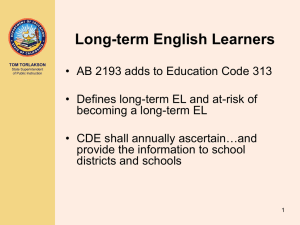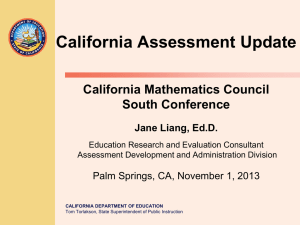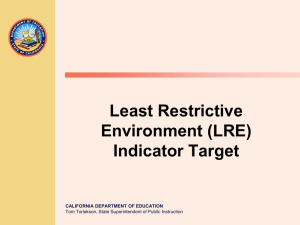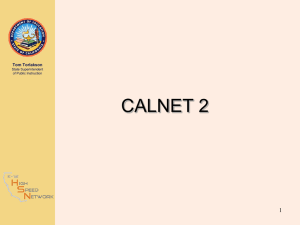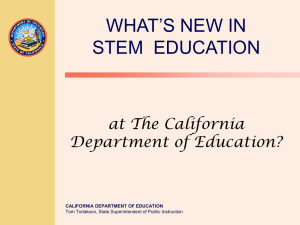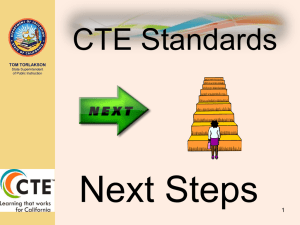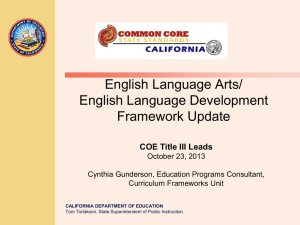Interim Assessments
advertisement
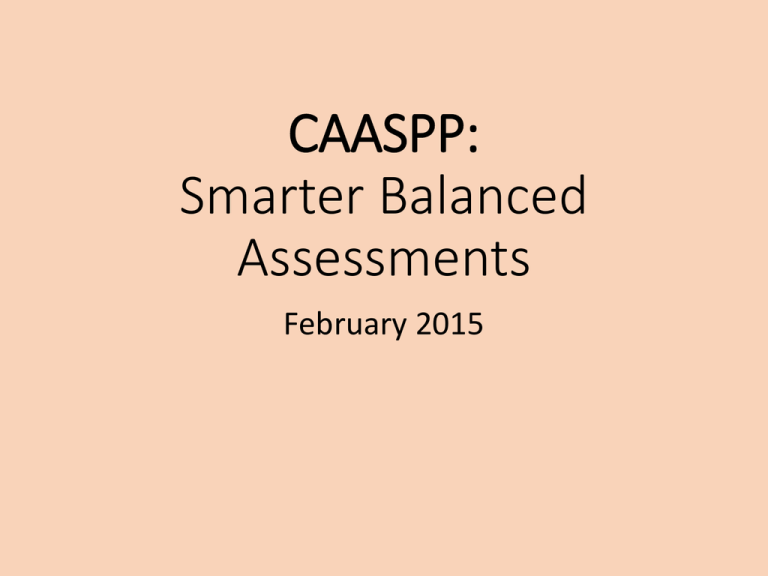
CAASPP: Smarter Balanced Assessments February 2015 Purpose • To provide information on the Smarter Balanced ELA and mathematics assessment blueprints that might be used for planning and designing instruction and classroom assessment • To provide information on the Smarter Balanced Achievement Levels and Achievement Level Descriptors • To increase awareness of how the blueprints and ALDs can support instructional planning, delivery and classroom assessment Purpose • To increase awareness of the resources available in the Smarter Balanced Digital Library • To increase awareness of the interim assessments • To respond to and gather questions about the Smarter Balanced components Agenda • Smarter Balanced Claims • Smarter Balanced Blueprints • Smarter Balanced Assessment Targets • Achievement Levels and Achievement Level Descriptors • Digital Library • Interims • Q&A Smarter Balanced Assessment Claims • “Claims are the broad statements of the assessment system’s learning outcomes…” • “A claim is a summary statement about the knowledge and skills students will be expected to demonstrate on the assessment related to a particular aspect of the CCSS.” ELA Claims Overall Claim Grades 3-8 “Students can demonstrate progress toward college and career readiness in English language arts and literacy.” Overall Claim Grade 11 “Students can demonstrate college and career readiness in English language arts and literacy.” Claim 1: Reading “Students can read closely and analytically to comprehend a range of increasingly complex literary and informational texts.” Claim 2: Writing “Students can produce effective and well-grounded writing for a range of purposes and audiences.” Claim 3: Speaking & Listening “Students can employ effective speaking and listening skills for a range of purposes and audiences.” Claim 4: Research/Inquiry “Students can engage in research and inquiry to investigate topics, and to analyze, integrate, and present information.” Mathematics Claims Overall Claim for Students Grades 3-8 “Students can demonstrate progress toward college and career readiness in mathematics.” Overall Claim for Grade 11 “Students can demonstrate college and career readiness in mathematics.” Claim 1: Concepts and Procedures “Students can explain and apply mathematical concepts and interpret and carry out mathematical procedures with precision and fluency.” Claim 2: Problem Solving “Students can solve a range of complex well-posed problems in pure and applied mathematics, making productive use of knowledge and problem solving strategies.” Claim 3: Communicating Reasoning “Students can clearly and precisely construct viable arguments to support their own reasoning and to critique the reasoning of others.” Claim 4: Modeling and Data Analysis “Students can analyze complex, real-world scenarios and can construct and use mathematical models to interpret and solve problems.” Smarter Balanced Blueprints Bridge between CCSS and the Smarter Balanced interim and summative assessments Smarter Balanced Blueprints • Describe the content of the English language arts/literacy and mathematics summative assessments for grades 3–8 and grade 11 • And how that content will be assessed • Reflect the depth and breadth of performance expectations Smarter Balanced Blueprints • Include information about: • the number of items related to the assessment targets • CAT items • Performance Task items • Total items • depth of knowledge for items associated with each assessment targets Assessment Targets • “…the assessment targets describe the expectations of what will be assessed by the items and tasks within each claim. • These summative assessment targets (evidence) at each grade level represent the prioritized content for summative assessment.” Assessment Targets • Communicate the big picture, “larger intent” of the standards. • Assessment targets are the cluster headings from the mathematics standards. • Assessment targets are derived from the cluster headings of the ELA Anchor Standards. 12 Common Core Big Ideas Depth of Knowledge (DOKs) Mathematics ELA/Literacy DOK3 DOK4 DOK3 DOK4 Previous Assessments <2% 0% 20% 2% New SBAC Assessments 49% 21% 43% 25% Yuan & Le (2012); Herman & Linn (2013) from Linda Darling-Hammond, Assembly Hearing, 3.6.13 Cognitive Rigor Matrix – ELA 14 ELA Blueprints • http://www.smarterbalanced.org/wordpress/wpcontent/uploads/2014/05/ELA_Preliminary_-Blueprint2014_04-30Final.pdf Summative Assessment Blueprint: ELA ELA Grade 3, Claim 1, Target 1 4. REASONING & EVIDENCE: Given an inference or conclusion, use explicit details and implicit information from the text to support the inference or conclusion provided Standards: RL-1 DOK 3 After reading the passage “A Few New Neighbors” by Kerry McGee, answer the following questions: 1. Read the sentence and the directions that follow. Children and adults can work together. Click the two details that best support this conclusion. • One afternoon, Jessie spotted a tiny bird fluttering around Mrs. Baxter’s front door. Mrs. Baxter had just moved into an apartment. • Jessie and Mrs. Baxter talked about the birds for a while. “They sound like house finches,” Mrs. Baxter said. “Keep and eye on them for me, will you?” 18 ELA Grade 8, Claim 2, Target 3b 3b REVISE BRIEF TEXTS: Apply a variety of strategies when revising one or more paragraphs of informational/explanatory text: organizing ideas by stating and maintaining a focus (thesis)/tone, providing appropriate transitional strategies for coherence, developing a topic including relevant supporting evidence/vocabulary and elaboration or providing a conclusion that is appropriate to purpose and audience and related to the information or explanation presented. Standards: W-3a, W-3b, W-3c, W-3d, and/or W-3e (DOK 2) 19 A student is writing a report for English class about famous Chicago landmarks. Read the paragraph from the draft and complete the task that follows: The home of the Chicago Cubs baseball team is one of the many famous landmarks in Chicago. Fans notice Wrigley Field’s one-of-a-kind feature, the ivycovered outfield walls, as soon as they enter through the ramps of the ballpark. Phillip K. Wrigley, owner of the team, wanted to beautify the stadium during a renovation of the bleachers in 1937. He hired Bill Veeck, General Manager of the Cubs, to lead the project. Veek arranged for Boston ivy to be grown on the walls of Wrigley Field. The lush ivy would be a soft landing spot for an outfielder catching a high fly ball. However, the brick wall standing behind the ivy is not something any ballplayer wants to hit with his head. . 20 The student thinks the paragraph needs an ending that is more appropriate for the audience. Choose the sentence that would best replace the underlined sentence. A. Baseballs have been known to get lost in the ivy. B. Bill Veeck deserves credit for the beauty of the ivy at Wrigley Field. C. To this day, Wrigley is the only ballpark with an ivycovered outfield wall. D. Fans flocking to the cozy confines of Wrigley Field would love to have a piece of the vines as a souvenir. 21 ELA Grade 11, Claim 3, Target 4 3. LISTEN /INTERPRET: Analyze, interpret and use information delivered orally Standards: SL-2, SL-3 (DOK 3) Listen to the presentation. Then answer the questions. “Mass Produced” Excerpt from The Big Book of Pop Culture: A How-To Guide for Young Artists by Hal Niedzviecki. Why does the author use the rhetorical technique of comparison to show how popular culture is mass produced? o To explain that ballet dancers are more athletic than actors o To suggest that ballet performances are more detailed than movies o To show how some forms are more difficult to reproduce than others 22 o To emphasize that the popularity of the contenct affects whether it can be reproduced. Grade 5 Claim 4 Target 3 3. ANALYZE INFORMATION/SOURCES: Distinguish relevantirrelevant information Standards: RI-7, W-8, W-9 (DOK 2 & 3) Review the three sources provided. Use the information from the sources to answer three questions. 1. The sources discuss how service animals help people. Explain what you have learned about how service animals help people. Use one detail from Source #1 and one detail from Source #2 to support your explanation. For each detail, include the source title or number. 23 Click on the boxes to match each source with the idea or ideas that it supports. Some ideas may have more than one source selected. Source #1 Monkey Helpers People who own businesses have to consider the well-being of all of their guests. 24 Being smart and able to handle small objects makes certain animals more appropriate than other animals to assist people who have a disability. Source #2 Animals Helping People Source #3 New Service Animal Rules Cognitive Rigor Matrix – Mathematics 25 Mathematics Blueprints http://www.smarterbalanced.org/wordpress/wpcontent/uploads/2014/05/Math_Preliminary_Blueprint-2014_04-30Final.pdf Summative Assessment Blueprint: Mathematics Claim 1 Assessment Targets Claim 1: “Students can explain and apply math concepts and interpret and carry out mathematical procedures with precision and fluency.” Standards for Mathematical Practice 1. 2. 3. 4. 5. 6. 7. 8. 29 Make sense of problems and persevere in solving them. Reason abstractly and quantitatively. Construct viable arguments and critique the reasoning of others. Model with mathematics. Use appropriate tools strategically. Attend to precision. Look for and make use of structure. Look for and express regularity in repeated reasoning. Standards for Mathematical Practice Match the claims to the Practice 1. 2. 3. 4. 5. 6. 7. 8. Make sense of problems and persevere in solving them. #2 Reason abstractly and quantitatively. #4 Construct viable arguments and critique the reasoning of others. Model with mathematics. #4 Use appropriate tools strategically. #2 & #4 Attend to precision. #3 Look for and make use of structure. #2 Look for and express regularity in repeated reasoning. #2 30 #3 Claim 1, Target 1A, DOK 1 31 Claim 2, Targets 2A, 1A, DOK 2 32 Claim 3, Targets 3E, 1A, DOK 3 Jada has a rectangular board that is 60 inches long and 48 inches wide. a. How long is the board measured in feet? How wide is the board measured in feet? b. Find the area of the board in square feet? c. Jada said, To convert inches to feet, I should divide by 12. The board has an area of 48 in x 60 in = 2880 in2 If I divide the area by 12, I can find the area in square feet . So the area of the board is 2880 ÷ 12 = 240 ft2. d. What went wrong with Jada’s reasoning? Explain. 33 Claim 4, Targets 4A, B, 1A, DOK 3 34 Bead Bracelets (continued) 35 Bead Bracelets (continued) 36 Bead Bracelets (continued) 37 What’s the DOK level? Sally built a pen for her dog Callie. The pen is 4 ft by 8 ft. What is the area of Callie’s pen? How could we change this to a DOK 1 problem? How could we change this to a DOK 3 or 4 problem? 38 Achievement Levels and Achievement Level Descriptors Achievement Level Descriptors • A means of describing performance on a standardized test in terms of levels or categories of performance. • To be reported in terms of four levels of achievement Level 1 through Level 4. • Text/narrative descriptions of the knowledge, skills, and processes demonstrated by students at each level of achievement. Range ALDs • Range ALDs describe: • the cognitive and content rigor within achievement levels • the knowledge, skills, and processes that students should have • a progression of development of knowledge, skills and processes Threshold ALDs • Threshold ALDS • define the minimum performance required for meeting an achievement-level expectation • reflect the knowledge, skills, and processes that are expected of students • The student who has achieved the threshold Level 3 is assumed to have the knowledge, skills, and processes of the range Levels 1 and 2 ALDs. Use of ALDs • “These ALDs are not intended to provide guidance to classroom teachers for curriculum or individual student decisions. Such guidance will be provided through the formative assessments.” • Provide context for teachers • Expectations on assessment targets • Range of achievement within the grade level • Learning progression within the grade level Range ALD Grade 3 Geometry Example: Mathematics • Target K : Reason with shapes and their attributes. • Level 1 students should be able to recognize rhombuses, rectangles, and squares. Range ALD Grade 3 Geometry Example: Mathematics • Target K : Reason with shapes and their attributes. • Level 3 students should be able to draw examples of quadrilaterals as examples that do not belong to given subcategories by reasoning about their attributes; partition shapes into equal areas and express the area of each part as a unit fraction of the whole; and understand that shapes in different categories may share attributes and that the shared attributes can define a larger category. Threshold ALD Grade 3 Geometry Example: Mathematics • The student who just enters level 3 should be able to: • Draw examples of quadrilaterals that do not belong to given subcategories by reasoning about their attributes. Range ALD Grade 4 Literary Texts Example: ELA • Target 12: Interpret, explain, or connect information presented within or across texts (e.g. compare/contrast, cause/effect, integrate information). • Level 1 students should be able to minimally interpret, explain, or connect information presented within or across texts of low complexity. • Level 2 students should be able to partially interpret, explain, or connect information presented within or across texts of moderate complexity. Range ALD Grade 4 Literary Texts Example: ELA • Target 12: Interpret, explain, or connect information presented within or across texts (e.g. compare/contrast, cause/effect, integrate information). • Level 3 students should be able to adequately interpret, explain, or connect information presented within or across texts of medium to high complexity. • Level 4 students should be able to thoroughly interpret, explain, or connect information presented within or across texts of unusually high complexity. Threshold ALD Grade 4 Literary Texts Targets 8-14 Example • The student who just enters level 3 should be able to: • Use details and information from texts of moderate complexity to support answers and inferences. • Identify or summarize central ideas/key events in texts of moderate complexity. • Use supporting evidence to justify/explain own inferences in texts of moderate complexity. Time to Explore and Consider • Choose a content area and grade level. • Review the range and threshold achievement level descriptors for that content and grade level. • How might these be useful to teacher teams? ALDs • http://www.smarterbalanced.org/wordpress/wpcontent/uploads/2012/11/Smarter-Balanced-ELALiteracy-ALDs.pdf • http://www.smarterbalanced.org/wordpress/wpcontent/uploads/2012/11/Smarter-Balanced-MathALDs.pdf Threshold ALDs and Overall Scale Scores • The threshold ALDs were used as a tool by panelists that participated in the Smarter Balanced Standard Setting process. • The scale scores relate to the skills and knowledge (as described in the Threshold ALDs) that a student demonstrates at the beginning/entry point of each achievement level. Preparing for New Assessment Results • Smarter Balanced assessments measure the full range of the Common Core State Standards. They are designed to let teachers and parents know whether students are on track to be college- and career-ready by the time they graduate. • Because the new standards set higher expectations for students, expectations for student achievement are higher than they used to be. • As a result, it’s likely that fewer students will initially score at the higher achievement levels on the assessments. As students have more years of instruction based on the new standards, results from new assessments will demonstrate student growth over time. • The scores will set a new baseline for student performance and progess in California . Score Reports • Overall score: weighted composite • Narrative description of achievement level • Subscores based on claims: Above, At or Near, Below standard • Four for ELA • Three for mathematics (combines Problem Solving and Modeling & Data Analysis) TOM TORLAKSON State Superintendent of Public Instruction TOM TORLAKSON State Superintendent of Public Instruction Score Reports • http://www.smarterbalanced.org/?s=score+reports Remember! • Scale scores and achievement levels from the Smarter Balanced assessments cannot and should not be compared with data from the STAR/CST . • Different standards are being assessed • Different assessment methods are being used • Different levels of cognitive rigor are being addressed TOM TORLAKSON State Superintendent of Public Instruction Digital Library 64 A Balanced Assessment System Summative: Tests used for end-ofyear accountability and evaluation Common Core State Standards specify K-12 expectations for college and career readiness All students leave high school college and career ready Teachers and schools have information and tools they need to improve teaching and Formative resources: learning Interim Assessments: Educator resources that support measuring student learning in real-time during instruction Tests used for timely and periodic information based on local needs/goals 65 Digital Library • On-line collection of resources: TOM TORLAKSON State Superintendent of Public Instruction – Aligned with the intent of the Common Core State Standards – Contributed by educators for educators – Vetted against a set of quality criteria • Supports implementation of the formative assessment process • Incorporates collaboration features • Supports diverse groups of learners 66 State Network of Educators TOM TORLAKSON State Superintendent of Public Instruction Composition Expectations • 60–150 members per state • Comprised of K–12 educators and higher–education faculty • Each network has diverse expertise in: • Common Core State Standards (CCSS) mathematics and English–language arts, science, social science, general education, gifted and talented, English learners, and students with disabilities. • Participate in 5 trainings. • Help populate the Digital Library in advance of the June 2014 preview. • Submit and review resources using the Quality Criteria. • Use resources and collaboration tools for members’ own professional learning and instruction. • Provide feedback on the resources in the library, review and posting process, Quality Criteria, and usability of software. 67 What the Digital Library Is Not … TOM TORLAKSON State Superintendent of Public Instruction A bank of assessment items A library for general public (will require registration and login) A learning management system in which educators can register for training or receive credit by completing specific online courses A site to freely post resources 68 Definition of the Formative Assessment Process TOM TORLAKSON State Superintendent of Public Instruction Formative assessment is a deliberate process used by teachers and students during instruction that provides actionable feedback that is used to adjust ongoing teaching and learning strategies to improve students’ attainment of curricular learning targets/goals. 69 Four Attributes of the Formative Assessment Process TOM TORLAKSON State Superintendent of Public Instruction Clarify intended learning Act on evidence Elicit evidence Interpret evidence 70 Criteria for Resources TOM TORLAKSON State Superintendent of Public Instruction • Aligns with CCSS • Incorporates formative assessment practices • Demonstrates high-quality instruction • Addresses learner differences • Is engaging and user-friendly 71 Digital Library Resources • Interactive Professional Learning Modules • Resources for educators, students, and families Assessment Literacy Modules TOM TORLAKSON State Superintendent of Public Instruction • Frame Formative Assessment within a Balanced Assessment System • Articulate the Formative Assessment Process • Highlight Formative Assessment Practices and Tools • Interactive Professional Learning Modules • Instructional coaching for educators • Instructional materials for students Instructional Modules • Demonstrate/support effective implementation of the formative assessment process • Focus on key content and practice from the Common Core State Standards for Mathematics and English Language Arts • High-quality vetted instructional resources and tools for educators • High-quality vetted resources and tools for students and families Education Resources • Reflect and support the formative assessment process • Reflect and support the Common Core State Standards for Mathematics and English Language Arts • Create Professional Learning Communities 72 Assessment Literacy Modules •Interactive Professional Learning Modules •Resources for educators, students, and families TOM TORLAKSON State Superintendent of Public Instruction •Frame Formative Assessment within a Balanced Assessment System •Articulate the Formative Assessment Process • Highlight Formative Assessment Practices and Tools 73 Instructional Modules •Interactive Professional Learning Modules •Instructional coaching for educators •Instructional materials for students TOM TORLAKSON State Superintendent of Public Instruction •Demonstrate/support effective implementation of the formative assessment process •Focus on key content and practice from the Common Core State Standards for Mathematics and English Language Arts Literacy 74 Education Resources •High-quality vetted instructional resources and tools for educators •High-quality vetted resources and tools for students and families TOM TORLAKSON State Superintendent of Public Instruction •Reflect and support the formative assessment process •Reflect and support the Common Core State Standards for Mathematics and English Language Arts Literacy •Create Professional Learning Communities 75 Tour of the Digital Library Digital Library Log-in Page TOM TORLAKSON State Superintendent of Public Instruction 76 Digital Library Features TOM TORLAKSON State Superintendent of Public Instruction 77 Tour of the Digital Library Filter Example TOM TORLAKSON State Superintendent of Public Instruction 78 Tour of the Digital Library Resource Card Example TOM TORLAKSON State Superintendent of Public Instruction 79 Tour of the Digital Library Resource Page TOM TORLAKSON State Superintendent of Public Instruction 80 Tour of the Digital Library Collaboration Page TOM TORLAKSON State Superintendent of Public Instruction 81 Tour of the Digital Library Flag Page TOM TORLAKSON State Superintendent of Public Instruction 82 Interim Assessment Blocks Interactive Module TOM TORLAKSON State Superintendent of Public Instruction 83 Using Interim Assessment Blocks Elicit Baseline Evidence Using an Interim Assessment Block TOM TORLAKSON State Superintendent of Public Instruction Clarify Intended Learning Elicit Act on Evidence Interpret Evidence Evidence Digital Library Digital Library Clarify Intended Learning Elicit Act on Evidence Interpret Evidence Evidence Check Progress Using an Interim Assessment Block 84 Digital Library Registration TOM TORLAKSON State Superintendent of Public Instruction • Updated information e-mailed on 10/3014 and 1/15 • To Digital Library Coordinators • Memo and ART Tip Sheet 85 Log-in Credentials for Teachers Each LEA must: TOM TORLAKSON State Superintendent of Public Instruction • Register Schools (Institutions) • Register Teachers • Important to complete forms Accurately Role AssociatedEntityID Level District Coordinator CDS Code for the District DISTRICT DL_EndUser CDS Code for the District DISTRICT DL_EndUser CDS Code for the School INSTITUTION DL_EndUser CDS Code for the School INSTITUTION • Help: CalTAC at 855-631-1510 86 Digital Library Implementation TOM TORLAKSON State Superintendent of Public Instruction • Think through what the teachers might need • Provide hands-on training and support • Embed into existing meetings • Encourage collaborative exploration • Build the knowledge base around formative assessment practice 87 TOM TORLAKSON State Superintendent of Public Instruction Interim Assessments 88 Interim Assessments: Two Types TOM TORLAKSON State Superintendent of Public Instruction • Interim Comprehensive Assessments (ICAs) – Same design as summative tests – Assess the same claims and standards – Yield overall scale scores, performance level designation and claim score information • Interim Assessment Blocks (IABs) – – – – Assess smaller sets of targets Address specific content areas More flexible reported as “Below Standard, “At/Near Standard,” and “Above Standard” 89 Interim Comprehensive Assessments (ICAs) TOM TORLAKSON State Superintendent of Public Instruction Mirror the summative assessment: • Use the same blueprints as the summative. • Assess the same range of standards. • Have the same item types and formats. • Include performance tasks. • Require the same amount of administration time. • Provide overall scale scores, overall achievement levels, and claim scores 90 Interim Assessment Blocks (IABs) TOM TORLAKSON State Superintendent of Public Instruction Assess fewer sets of skills, and:. • Focus on fewer sets of skills • Flexible: supports instruction and curriculum • Include the same item types and formats, including classroom activities and performance tasks as the summative • Provide overall information for each block 91 Blocks for ELA, Grades 3 to 5 TOM TORLAKSON State Superintendent of Public Instruction Grades 3–5 Read Literary Texts Read Informational Texts Edit/Revise Brief Writes Listen/Interpret Research *Narrative Performance Task (Grades 4–5 only in 2014–15) *Informational Performance Task *Opinion Performance Task (Grade 3 only in 2014–15) *Will be available in 2015–16 92 Blocks for ELA, Grades 6 to 8 TOM TORLAKSON State Superintendent of Public Instruction Grade 6-8 Read Literary Texts Read Informational Texts Edit/Revise Brief Writes Listen/Interpret Research *Narrative Performance Task *Explanatory Performance Task Argument Performance Task *Will be available in 2015–16 93 Blocks for ELA, High School TOM TORLAKSON State Superintendent of Public Instruction High School Read Literary Texts Read Informational Texts Edit/Revise Brief Writes Listen/Interpret Research *Explanatory Performance Task Argument Performance Task *Will be available in 2015–16 94 Blocks for Mathematics, Grades 3 to 5 TOM TORLAKSON State Superintendent of Public Instruction IAB Name Grade 3 4 5 aaa Numbers and Operations in Base 10 * a a Fractions aaa Geometry * * Measurement and Data a * * Mathematics Performance Task aaa Operations and Algebraic Thinking *Will be available in 2015–16 95 Blocks for Mathematics, Grades 6 to 7 TOM TORLAKSON State Superintendent of Public Instruction IAB Name Ratio and Proportional Relationships Number System Expressions and Equations Geometry Statistics and Probability Mathematics Performance Task Grade 6 7 a a a a * a a a a * * a *Will be available in 2015–16 96 Blocks for Mathematics, Grades 6 to 7 TOM TORLAKSON State Superintendent of Public Instruction IAB Name Ratio and Proportional Relationships Number System Expressions and Equations Geometry Statistics and Probability Mathematics Performance Task Grade 6 7 a a a a * a a a a * * a *Will be available in 2015–16 97 Blocks for Mathematics, Grade 8 TOM TORLAKSON State Superintendent of Public Instruction Grade 8 *Expressions & Equations I (and Proportionality) *Expressions & Equations II Functions Geometry Mathematics Performance Task *Will be available in 2015–16 (available as a single Expressions & Equations Block in 2014–15) 98 Mathematics Blocks for High School High School TOM TORLAKSON State Superintendent of Public Instruction Algebra and Functions – Linear Functions Algebra and Functions – Quadratic Functions *Algebra and Functions – Exponential Functions *Algebra and Functions – Polynomials Functions *Algebra and Functions – Radicals Functions *Algebra and Functions – Rational Functions *Algebra and Functions – Trigonometric Functions *Geometry – Transformations in Geometry Geometry – Right Triangle Ratios in Geometry *Geometry – Three-Dimensional Geometry *Geometry – Proofs *Geometry – Circles *Geometry – Applications *Interpreting Categorical and Quantitative Data *Probability *Making Inferences and Justifying Conclusions Mathematics Performance Task *Will be available in 2015–16 99 Rollout of ICAs and IABs TOM TORLAKSON State Superintendent of Public Instruction • Initial item pool will be limited in depth. • Initial ICAs and IABs will be in a fixed format. • As the item pool grows, ICAs and IABs will become available as computer adaptive tests (CATs). 100 Administration TOM TORLAKSON State Superintendent of Public Instruction • ICAs and IABs are administered online (no paper versions) • ICAs and IABs use the same teacher registration process as the summative assessment • ICA and IAB administrationuse the same test delivery interface as the summative assessment. • ICAs and IABs items are not secure 101 Administering Interim Assessments Requires TOMS logon credentials TOM TORLAKSON State Superintendent of Public Instruction TOMS 1 2 Verify student demographic data Test Administrator Interface Administer assessments Interim Handscoring System 3 Handscore students’ constructed responses Grades Supported by Interim Assessments TOM TORLAKSON State Superintendent of Public Instruction LEAs need TOMS logins for: • Teachers in grades 3 to 8, and grade 11 (the grades that take the summative test) • Teachers in grades K, 1, 2, 9, 10, and 12 (the grades that might also use the Interim assessments) 103 Grades Supported by Interim Assessments for 2014–15 TOM TORLAKSON State Superintendent of Public Instruction Grade 3 Grade 4 Interim Tests: ELA and Mathematics Grade 5 Grade 6 Grade 7 Grade 8 High School Kindergarten Grade 1 Grade 2 Grade 3 Grade 4 Grade 5 Grade 6 Grade 7 Grade 8 Grade 9 Grade 10 Grade 11 Grade 12 104 Grade Level Access to Interims for 2014-15 • http://www.cde.ca.gov/ta/tg/ca/interimassessgraderef.asp Scoring of the Interim Assessments TOM TORLAKSON State Superintendent of Public Instruction • Most items are scored by the Smarter Balanced test delivery engine. • Scoring of constructed-response items and performance tasks is a local responsibility. • Score reports are generated once the constructed-response item scores and performance task scores are input into the system. 106 Scoring of the Interim Assessments (cont.) TOM TORLAKSON State Superintendent of Public Instruction • Hand-scoring process: −Online −Rubrics and anchor papers provided −Training Webcast scheduled for January 28 107 Training Material Objectives TOM TORLAKSON State Superintendent of Public Instruction • Provide a rubric for scoring each constructed response (open-ended) item • Provide scored student responses and scoring rationale − Scored student responses consist of “Anchor” responses which are the primary training tool along with the rubric. All anchor papers also contain annotations describing the scoring rationale 108 Rubrics by Item Type • Full Writes TOM TORLAKSON State Superintendent of Public Instruction – Rubrics are specific to a grade band and purpose. Each essay is evaluated on 3 elements of writing: • Conventions • Organization/Purpose • Evidence/Elaboration or Development/ Elaboration – In addition to the rubric, associated guidelines may be provided to further assist in scoring Rubrics by Item Type, (cont.) TOM TORLAKSON State Superintendent of Public Instruction • ELA – Research (Claim 4) – Rubrics are specific to a target • ELA – Brief Writes (Claim 2) – Rubrics are specific to a sub-target • ELA – Reading (Claim 1) – Rubrics are specific to a target • Math Performance Task – Each item has its own rubric, though the rubrics are similar across PT families 110 Sample Rubric ELA – Research TOM TORLAKSON State Superintendent of Public Instruction Sample Rubric – Math PT TOM TORLAKSON State Superintendent of Public Instruction Hand Scoring of Interims • http://www.cde.ca.gov/ta/tg/ca/iabhandscoring.asp Results from the Smarter Balanced Interim Assessments TOM TORLAKSON State Superintendent of Public Instruction • The ICAs and the IABs provide individual student results that teachers can examine in order to adjust instruction. – ICA: Overall scale score and Score of “Below” “At/Near” or “Above” Standard for each Claim – IAB: Score of “Below” “At/Near” or “Above” Standard for each Block 114 Obtaining Student Reports TOM TORLAKSON State Superintendent of Public Instruction Requires TOMS logon credentials TOMS 1 Verify student demographic data Requires same logon credentials used for the Digital Library 2 Test Administrator Interface Administer assessments Interim Handscoring System 3 Handscore students’ constructed responses 4 Data Warehouse Receive and view student reports Individual Student Report TOM TORLAKSON State Superintendent of Public Instruction 116 Students in a GRADE – ICA Home Example State Bay View School District Bay View Central High Grade 11 TOM TORLAKSON State Superintendent of Public Instruction Page 117 Students in a GRADE – ICA Mathematics TOM TORLAKSON Home Example State State Superintendent Bay View School District Bay View Central High Grade 11 of Public Instruction Page 118 TOM TORLAKSON State Superintendent of Public Instruction Suggested Uses of the Interim Assessments in 2014−15 119 Inform Teaching and Learning TOM TORLAKSON State Superintendent of Public Instruction • Administer IAB(s) that align with current curriculum and pacing • Use IAB results with other sources of evidence to identify student strengths and weaknesses • Evaluate instructional progress and plan adjustments to increase student learning Authentic Experience TOM TORLAKSON State Superintendent of Public Instruction • Create test sessions, pause the test, experience the same interface, etc. • Respond to different types of questions • Use authentic technology – Keyboard – Mouse – Graphing • Experience content reflective of summative • Gauge time needed to complete the summative test Accessibility Supports TOM TORLAKSON State Superintendent of Public Instruction • Universal tools, designated supports, and accommodations are modifiable on the TA Interface for the interim tests. − Provides an excellent opportunity to try out accessibility supports with students and actual test items • Note: Only universal tools will be modifiable on the TA Interface for the summative tests. Handscoring TOM TORLAKSON State Superintendent of Public Instruction • Helps build content knowledge and supports collaboration within the school • Provides a clear sense of where the student’s strengths and weaknesses are • Builds teacher comfort with technology and the process of online scoring • Gives a sense of the time required to hand score • Through anchor papers, exemplifies the criteria present in the rubric Implementation Plan 2015–16 TOM TORLAKSON State Superintendent of Public Instruction • Become familiar with the Interim Assessments •Evaluate the district’s available technology • Plan how to roll out the Interims next year: –Locus of control/roles and responsibilities –Student registration –Accessibility supports –Teacher log-ins and security agreements –Scoring (training and time to score) –Technology –Scheduling –Troubleshooting Immediate Considerations TOM TORLAKSON State Superintendent of Public Instruction • Ensure all teachers have access to the appropriate systems to administer the interims (e.g., grades 3 through 8, and grade 11; AND grades 2, 9, 10 and 12 teachers) • Obtain security agreements from teachers • Ensure student demographic data is correct in California Longitudinal Pupil Achievement Data System (CALPADS) – Especially students’ Statewide Student Identifiers (SSIDs) and grade level • Provide test administration training for new teachers • Provide interim handscoring training for teachers Resources for Interim Assessments TOM TORLAKSON State Superintendent of Public Instruction • Interim Assessment Administration Resource Guide: http://www.caaspp.org/administration /instructions/index.html 126 TOM TORLAKSON State Superintendent of Public Instruction Questions? 127 Training Resources TOM TORLAKSON State Superintendent of Public Instruction • www.caaspp.org – Test Administration – Training – TA Resources 128 For Further Information TOM TORLAKSON State Superintendent of Public Instruction California Department of Education CAASPP Office caaspp@cde.ca.gov 916-445-8765 CAASPP.org http://caaspp.org/ 1-800-955-2954 129 Contact Information TOM TORLAKSON State Superintendent of Public Instruction Kathy Caric kcaric@cde.ca.gov 661-703-4575 130
